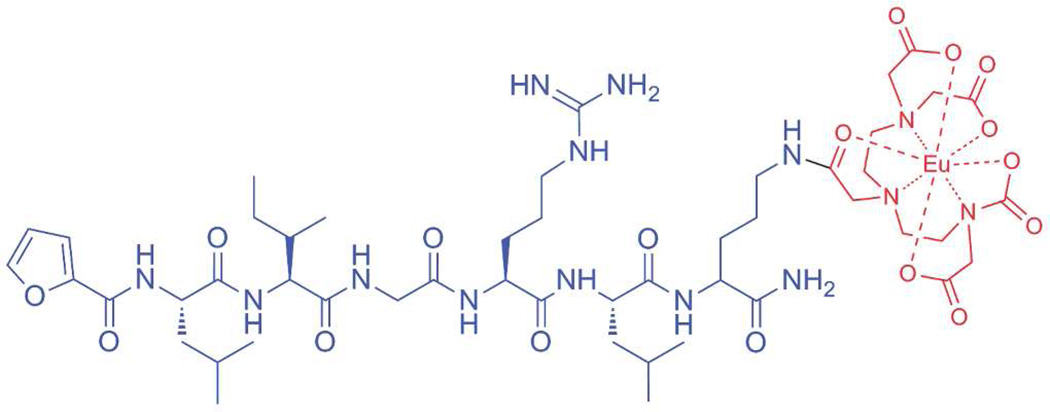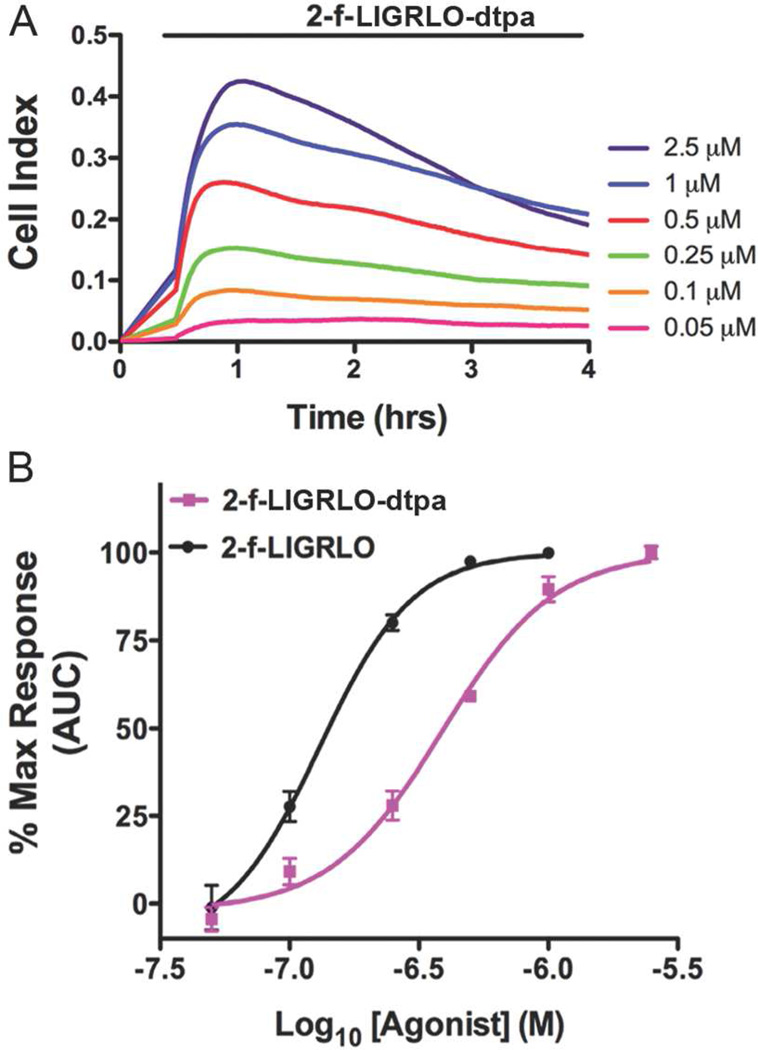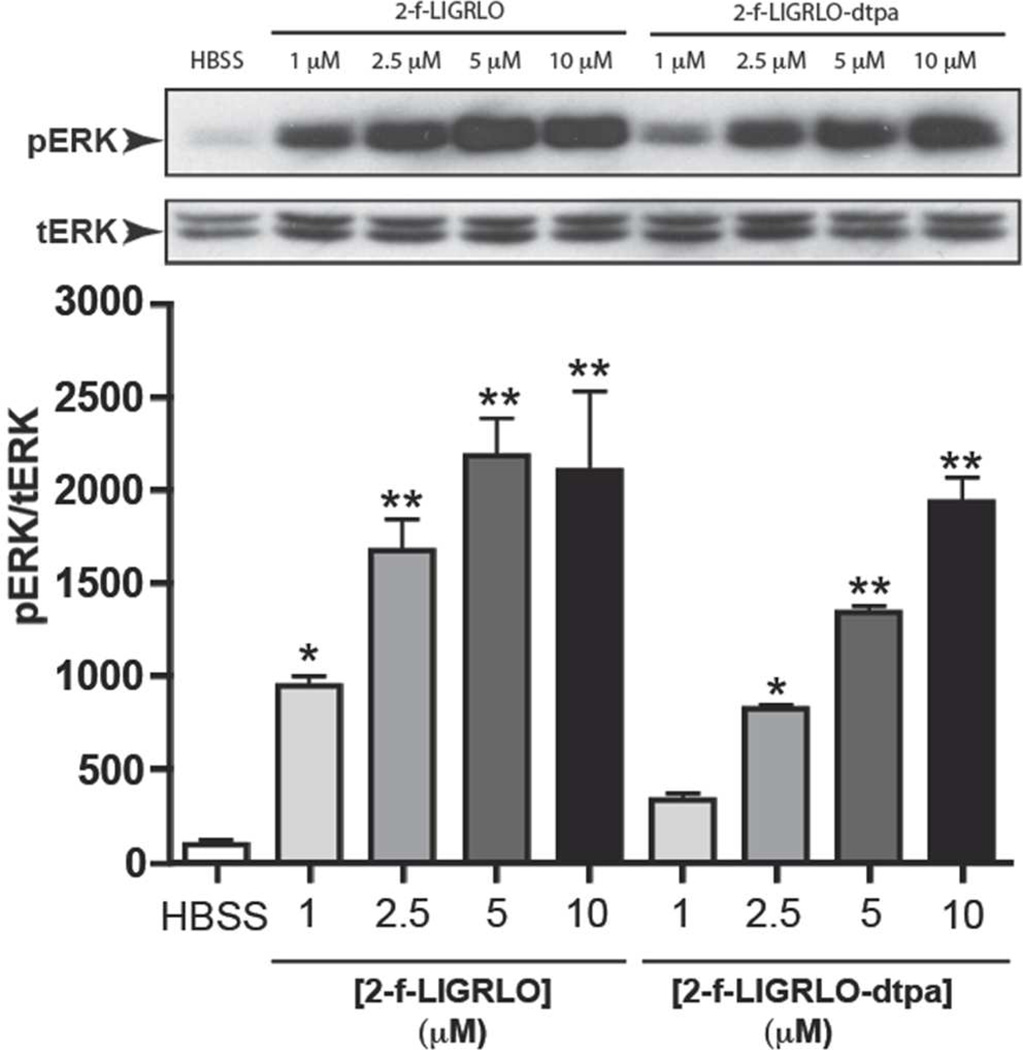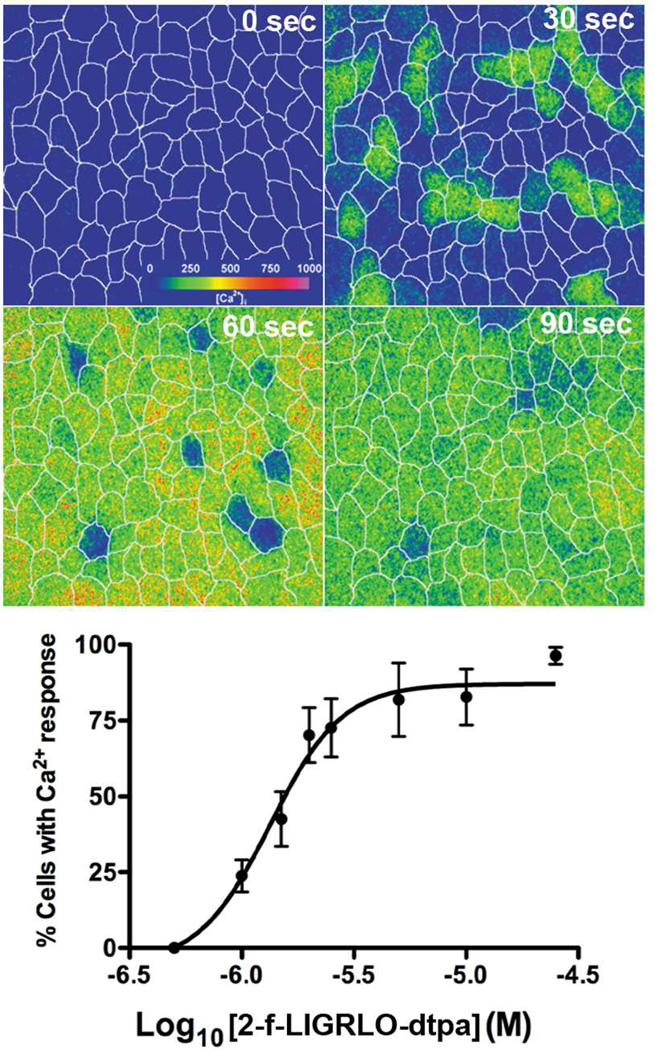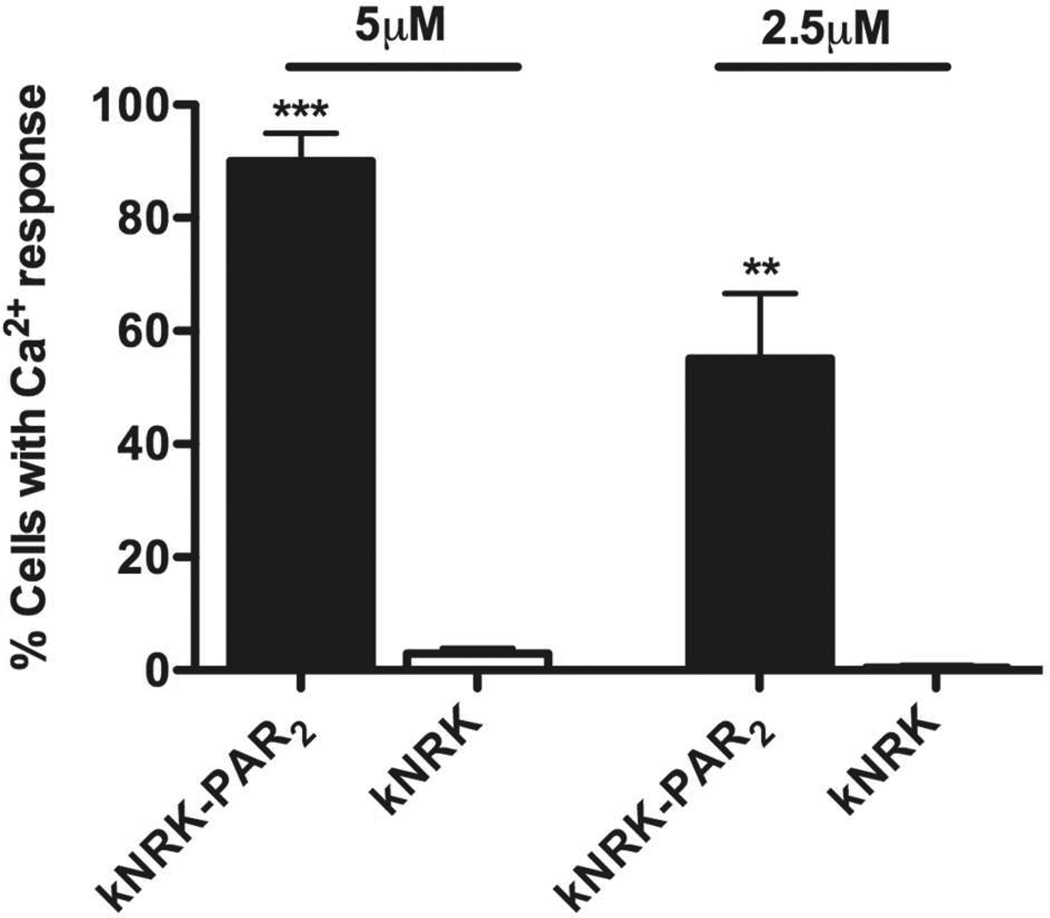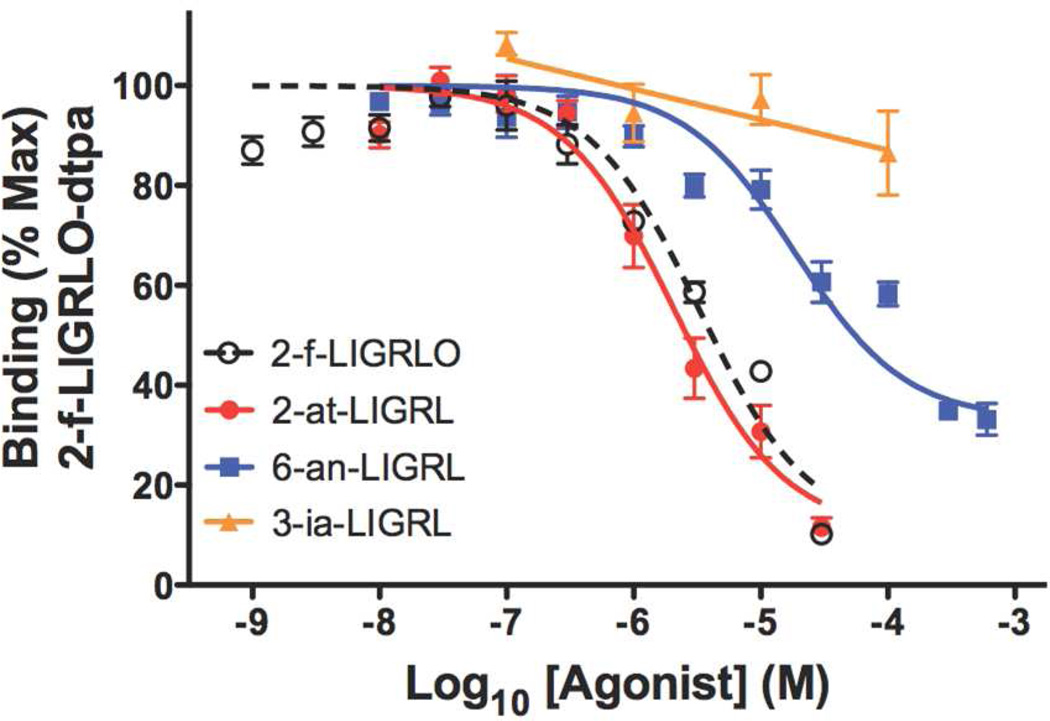Abstract
Protease activated receptor-2 (PAR2) is one of four G-protein coupled receptors (GPCRs) that can be activated by exogenous or endogenous proteases, which cleave the extracellular amino-terminus to expose a tethered ligand and subsequent G-protein signaling. Alternatively, PAR2 can be activated by peptide or peptidomimetic ligands derived from the sequence of the natural tethered ligand. Screening of novel ligands that directly bind to PAR2 to agonize or antagonize the receptor has been hindered by the lack of a sensitive, high-throughput, affinity binding assay. In this report we describe the synthesis and use of a modified PAR2 peptidomimetic agonist, 2-furoyl-LIGRLO-(diethylenetriaminepentaacetic acid)-NH2 (2-f-LIGRLO-dtpa), designed for lanthanide-based time resolved fluorescence screening. We first demonstrate that 2-f-LIGRLO-dtpa is a potent and specific PAR2 agonist across a full spectrum of in vitro assays. We then show that 2-f-LIGRLO-dtpa can be utilized in an affinity binding assay to evaluate the ligand-receptor interactions between known high potency peptidomimetic agonists (2-furoyl-LIGRLO-NH2, 2-f-LIGRLO; 2-aminothiazol-4-yl-LIGRL-NH2, 2-at-LIGRL and; 6-aminonicotinyl-LIGRL-NH2, 6-an-LIGRL) and PAR2. A separate N-terminal peptidomimetic modification (3-indoleacetyl-LIGRL-NH2, 3-ia-LIGRL) that does not activate PAR2 signaling was used as a negative control. All three peptidomimetic agonists demonstrated sigmoidal competitive binding curves, with the more potent agonists (2-f-LIGRLO and 2-at-LIGRL) displaying increased competition. In contrast, the control peptide (3-ia-LIGRL) displayed limited competition for PAR2 binding. In summary, we have developed a Europium-containing PAR2 agonist that can be used in a highly sensitive affinity binding assay to screen novel PAR2 ligands in a high-throughput format. This ligand can serve as a critical tool in the screening and development of PAR2 ligands.
INTRODUCTION
PAR2 is one of a four-member family of GPCRs that are activated in response to numerous different proteases1–5. PAR2 is expressed in a variety of cell types and associated with a number of diseases including arthritis, allergic asthma, cancer, and acute and chronic pain. Similar to the other PARs, proteolytic cleavage of the extracellular N-terminus exposes a tethered ligand sequence. This ligand intramolecularly binds to the receptor to initiate G-protein dependent and independent intracellular signaling pathways1,5,6. Exposure of the primary PAR2 protease cleavage site reveals a tethered ligand (peptide sequence ending in SLIGRL in rodent and SLIGKV in humans) that elicits two dominant intracellular signaling events: an increase in intracellular calcium ion concentration ([Ca2+]i) and increased phosphorylation of mitogen activated protein kinases (MAPKs). Interestingly, alternative protease cleavage sites and subsequent ligands can induce biased MAPK signaling over Ca2+ signaling, and potentially, alternative physiological responses initiated at PAR2,5–8. All of the possible signaling and physiological outcomes that follow PAR2 activation share in common a ligand-receptor interaction. While this ligand-receptor interaction is important to initiate signaling, the interaction itself remains ill-defined.
Small activating peptides or peptidomimetics that mimic the binding properties of the natural tethered ligand can activate PAR2 specifically and potently in the absence of proteolytic cleavage1,3,5,9. Such ligands have the specific advantage of eliminating the potential off-target effects of proteases that limit the use of proteases and protease inhibitors in evaluating PAR2 effects in vitro and in vivo. The continued screening and development of novel ligands that specifically bind PAR2 to agonize or antagonize the receptor can serve as probes to better characterize downstream signaling pathways of PAR2, its physiological and pathophysiological roles, and serve as templates for drug design. We recently developed a high-throughput in vitro screening assay that includes physiological and signaling pathway responses to PAR2 ligands9. This method helped to establish full characterization of known and novel PAR2 ligands; however, it lacked a biochemical approach to evaluate direct interactions between novel ligands and PAR2.
Published methods for evaluating PAR2 ligand-receptor interactions include the use of peptidomimetic analogs (trans-cinnamoyl-LIGRLO-NH2, 2-furoyl-LIGRL-NH2 and 2-furoyl-LIGRLO-NH2) modified by radiolabels or traditional fluorescence10–13. These studies demonstrated binding curves and evaluated PAR2 ligand binding (e.g., IC50s10,13, Kis11–13, relative Kis (compared to SLIGKV-OH)12,13 or relative IC50s (compared to SLIGRL-NH2)10,11 following competitive binding assays in tissue culture plates and/or suspended cultures. While these assays showed the utility of modifying known peptidomimetic ligands to develop competitive binding assays, a distinct disadvantage of these ligands is their limited adaptability to high-throughput analyses, thus compromising their use for PAR2 ligand discovery. The recent development of lanthanide series luminescence/fluorescence assays allows for fluorescence-detection based competitive binding assays in vitro using a multi-well plate format, as well as the potential to develop similar probes for in vivo PAR2 studies14,15
Lanthanides (e.g., Terbium, Tb; Dysprosium, Dy; Europium, Eu; Samarium, Sm) exhibit the unique characteristics of a low detection limit (10−12–10−15 M), narrow emission bands (10–20 nm), large Stokes shift (greater than 200 nm), and long-lived fluorescence (milliseconds for Eu)16–18. Prolonged fluorescence enables the use of time-resolved fluorescence (TRF) measurements18, greatly improving the signal to noise ratio19 and thus, increases fluorescent measurement sensitivity. We wanted to take advantage of the physical properties of lanthanides and used a modified Dissociation Enhanced Lanthanide Fluoroimmunoassay (DELFIA; Wallac/PerkinElmer Life Sciences) to carry out competitive binding assays. This technique has proven to be successful in screening (e.g. ligand binding assays), biodistribution and biomedical applications and is the most successful lanthanide-based immunoassay reported to date14,17,18,20.
In this study we sought to develop a potent, PAR2-specific ligand, whose characteristics allow for a functional high-throughput screening assay to characterize ligand-receptor interactions. We synthesized a derivative of the highly potent 2-f-LIGRLO modified with diethylenetriaminepentaacetic acid (dtpa), which serves as the chelate for a Europium (III) to be used in a time-resolved fluorescence assay14,17,18. The resulting compound, 2-f-LIGRLO-dtpa was first characterized for its ability to function as a full and specific PAR2 agonist using both in vitro physiological and cellular signaling assays. We next showed that 2-f-LIGRLO-dtpa can be used in a competitive binding assay with potent, full PAR2-specific agonists (2-f-LIGRLO, 2-at-LIGRL, and 6-an-LIGRL), and the inactive peptidomimetic 3-ia-LIGRL. We propose that 2-f-LIGRLO-dtpa can be used to evaluate PAR2 ligand-receptor interactions to both screen novel compounds and to better understand the role of ligand-receptor interactions in the signaling pathway-specific activation of PAR2.
EXPERIMENTAL PROCEDURES
Materials
Materials and chemicals were of molecular biology grade or higher. Sources are listed in the Supplemental Material.
PAR2 ligand synthesis
Peptides and peptidomimetics (2-f-LIGRLO, 2-at-LIGRL, 6-an-LIGRL and 3-ia-LIGRL) were prepared as previously described21. The lanthanide-labeled peptidomimetic, 2-f-LIGRLO-dtpa was made by coupling dtpa to the ε-amino group of the ornithine in the parent PAR2 ligand, 2-f-LIGRLO (Figure 1) followed by the chelation of a Europium (III) ion via a synthesis scheme previously described18. Specific details on syntheses and purity are provided in the Supplemental Material.
Figure 1. Structure of 2-furoyl-LIGRLO-dtpa-NH2 (2-f-LIGRLO-dtpa).
A) Chemical structure of the parent PAR2 hexapeptidomimetic 2-furoyl-LIGRLO-NH2 is shown in blue. The diethylenetriaminepentaacetic acid (dtpa) chelating a Europium (III) and conjugated with the parent compound via the ε ornithine is shown in red.
Epithelial cell culture and cellular signaling measurements
The 16HBE14o- human bronchial epithelial cell line was used for physiological and second messenger screening assays and in competitive binding experiments were grown as previously described9. PAR2 and vector control-transfected Kirsten virus-transformed normal rat kidney (kNRK-PAR2 and kNRK, respectively) cells were used to test specificity of the 2-f-LIGRLO-dtpa ligand. Cell growth and specifics on physiological and signaling analyses are described in the Supplemental Material.
Competitive binding assay
Black 96-well plates with white, opaque wells were initially incubated with a matrix coating solution (MCS consisting of 88% LHC basal medium, 10% bovine serum albumin (BSA), 1% bovine collagen type I and 1% human fibronectin for two h at 37°C. MCS was removed and plates allowed to dry for at least one h. 16HBE14o- cells were plated on at a density of 6.0 × 104 cells per well and grown at 37°C, 5% CO2 to confluence (4 – 5). On the day of the experiment, growth media was aspirated using a multi-well vacuum manifold (Corning Inc, Corning, NY) and cells were washed with 200 µl of pre-warmed (37°C) Hanks’ balanced saline solution additionally buffered with 25 mM HEPES, pH 7.4 (HBSS) using a multi-channel pipet. HBSS was replaced with 100 µl of a 2% BSA in HBSS solution and incubated for 75 min to block non-specific interactions. All peptide competition solutions were made at 2× final concentration in a deep well mixing plate. Competition solutions consisted of a fixed concentration of 2-f-LIGRLO-dtpa (final concentration: 300 nM) and concentration response concentrations of peptidomimetics (final concentrations: 1 nM to 600 µM in log or ½ log steps). 100 µl of competition solutions were added to each well in the 96-well plate (final volume of 200 µl) and incubated with the BSA-blocked live cells for 45 min at 25°C. Competition solutions were carefully removed, and cells were washed three times with a wash solution (Base medium: HBSS supplemented with 20 µM EDTA, 0.01% Tween, and 0.2% BSA). The wash solution was removed and replaced with 100 µl of DELFIA enhancement solution (Perkin Elmer; Waltham, MA) for 40 – 45 min at room temp and fluorescence determined as previously described17,18. Briefly, 96-well plates were read on a Wallac VICTOR3 instrument (Perkin Elmer; Waltham, MA) using standard Eu time-resolved fluorescence (TRF) measurement: excitation light (340 nm) followed by a 400 µsec delay before a 400 µsec emission collection (615 nm). The total measurement cycle was set to 1000 µsec per well.
Statistics
All statistical analyses were evaluated with GraphPad software (San Diego, CA). Multivariate comparisons were done with a one-way ANOVA with Tukey’s multiple comparison post-test. Pair-wise comparisons were done with a 2-tailed Student’s t test. Relative IC50s were calculated using a one-site fit logIC50 non-linear regression curve-fit analysis. A value of p < 0.05 was used to establish a significant difference between samples. Data in figures are graphed as ± SEM unless otherwise noted.
RESULTS
Evaluation of 2-f-LIGRLO-dtpa as a full PAR2 agonist
We used a high PAR2-expressing human bronchial epithelial cell line (16HBE14o-)22 to evaluate the ability of 2-f-LIGRLO-dtpa to activate PAR2 with a three-tiered screening assay that included in vitro physiological, MAPK signaling and Ca2+ signaling assays9. To examine physiological activation of 16HBE14o- cells by 2-f-LIGRLO-dtpa, we used the xCELLigence Real Time Cell Analyzer (Roche; RTCA). Cells were exposed to a concentration response (0.05 µM–2.5 µM) of either the parent compound, 2-f-LIGRLO, or 2-f-LIGRLO-dtpa and examined for the ability of each compound to activate PAR2 (Figure 2). We found 2-f-LIGRLO-dtpa stimulated a maximum Cell Index at a concentration of 2.5 µM. The calculated EC50 of 2-f-LIGRLO-dtpa (388 nM; 95% CI, 336 – 448 nM) was slightly less potent than 2-f-LIGRLO (130 nM; 95% CI, 107 – 159 nM), and similar to another highly potent peptidomimetic PAR2 agonist, 6-an-LIGRL9.
Figure 2. 2-f-LIGRLO-dtpa stimulates a physiological response in model epithelial cells.
(A) 16HBE14o- cells were plated onto E-plates, exposed to a concentration response (50 nM – 2.5 µM) of 2-f-LIGRLO-dtpa and Cell Index was measured every 15 s for 4 h. Cells showed a concentration-dependent physiological response over the 4 h experiment. (B) A concentration response curve was constructed for 2-f-LIGRLO-dtpa and the high potency agonist 2-f-LIGRLO from the area under the curve of individual experiments. EC50 for 2-f-LIGRLO-dtpa (388 nM) is consistent with a potent full agonist, albeit slightly reduced from 2-f-LIGRLO (130 nM)9. Traces in (A) and curves in (B) are mean responses from 4 experiments, error bars are eliminated in (A) for clarity.
We next evaluated the ability of 2-f-LIGRLO-dtpa to induce MAPK signaling pathways. 16HBE14o- cells were exposed to a concentration response (1 – 10 µM) of 2-f-LIGRLO-dtpa for 5 min, and examined for activation of MAPK signaling using immunoblot of pERK/tERK (Figure 3). Exposure of 2.5 µM 2-f-LIGRLO-dtpa to 16HBE14o- cells induced a significant increase in pERK/tERK when compared with control. Increasing concentrations up to 10 µM 2-f-LIGRLO-dtpa induced higher pERK/tERK values. In the same assay, 2-f-LIGRLO induced a significant increase of pERK/tERK at 1 µM exposure, and reached a maximum by 5 µM exposure. Although 2-f-LIGRLO-dtpa was slightly less potent than 2-f-LIGRLO, it was comparable to alternative full peptidomimetic agonists 2-at-LIGRL and 6-an-LIGRL9.
Figure 3. 2-f-LIGRLO-dtpa stimulates MAPK signaling in model epithelial cells.
16HBE14o- cells were exposed to a concentration response of either 2-f-LIGRLO or 2-f-LIGRLO-dtpa for 5 min. Representative immunoblots show increased ERK1/2 phosphorylation (pERK) compared to total ERK1/2 (tERK) beginning at 1 µM agonist concentration and maintained at concentrations up to 10 µM for each ligand. Densitometric quantification (n=4) demonstrates significant increase of pERK at 1 µM and peak activation by 5 µM for 2-f-LIGRLO, while 2-f-LIGRLO-dtpa was slightly less potent, with a significant increase in pERK at 2.5 µM and a peak response by 10 µM. Significant difference from matching HBSS control are shown: “*”, p < 0.05; “**”, p < 0.01.
In a complementary signaling assay to evaluate PAR2 activation by 2-f-LIGRLO-dtpa, we examined the activation of Ca2+ signaling in 16HBE14o- cells using digital imaging microscopy9,21. Upon addition of 5 µM 2-f-LIGRLO-dtpa, an initial increase in [Ca2+]i was observed within 30 sec, with a peak response observed between 45 and 60 sec (Figure 4; supplemental video). The majority of cells in the field of view responded within the 3 min experiment. An advantage of this imaging method is the detection of [Ca2+]i changes in individual cells and thus, an increased sensitivity in the PAR2 response. A concentration response curve (0.5 µM – 25 µM 2-f-LIGRLO-dtpa) is shown in Figure 4B. The EC50 for 2-f-LIGRLO-dtpa (1.34 µM; 95% CI, 0.85–2.11 µM), was slightly less efficacious than that reported for 2-f-LIGRLO but more efficacious than another high potency PAR2 specific agonist, 2-at-LIGRL9,21. In summary, 2-f-LIGRLO-dtpa displays signaling responses across a variety of assays that are similar to other high potency, full PAR2 agonists.
Figure 4. 2-f-LIGRLO-dtpa stimulates Ca2+ signaling in model epithelial cells.
16HBE14o-cells were exposed to 2-f-LIGRLO-dtpa and [Ca2+]i was monitored over time. (A) Individual panels depict [Ca2+]i in all cells within a field of view at listed times (sec) following application of 5 µM 2-f-LIGRLO-dtpa at time 0. White lines approximate individual cell borders in each image and estimated [Ca2+]i is depicted in the color bar shown in upper left panel. 2-f-LIGRLO-dtpa stimulates a rapid increase in [Ca2+]i that reaches peak changes by 45 – 60 sec in most cells and begins to return towards base line by 90 sec. (B) Percentage of cells in the field of view that show [Ca2+]i responses within the 3 min experiment are graphed as a concentration response to 2-f-LIGRLO-dtpa. The calculated EC50 of 2-f-LIGRLO-dtpa for a Ca2+ response is 1.34 µM, comparable to known full PAR2 agonists9. A minimum of 3 and maximum of 9 experiments are plotted for each concentration shown in (B).
Specificity of 2-f-LIGRLO-dtpa to PAR2
To test the specificity of 2-f-LIGRLO-dtpa, we used Kirsten virus-transformed normal rat kidney cells, a low-PAR2 expressing epithelial cell line. We compared the activation of Ca2+ signaling in PAR2-transfected kNRK cells (kNRK-PAR2) to those transfected with a control vector (kNRK) (Figure 5). Exposure of kNRK-PAR2 cells to 5 µM or 2.5 µM 2-f-LIGRLO-dtpa resulted in Ca2+ signaling in a high percentage of cells (90.1% ± 4.8 and 55.1% ± 11.5, respectively). Similar experiments using kNRK cells resulted in limited Ca2+ signaling (2.98% ± 0.09 and 0.42% ± 0.42, respectively). These results indicate our novel 2-f-LIGRLO-dtpa ligand requires PAR2 for initiating cellular signaling and thus, is a specific agonist to PAR2.
Figure 5. 2-f-LIGRLO-dtpa requires PAR2 expression to induce Ca2+ signaling.
PAR2-transfected (kNRK-PAR2) or control vector-transfected (kNRK) rat kidney cells were exposed to 2-f-LIGRLO-dtpa and evaluated for Ca2+ response as described in Fig. 4. Addition of 5 or 2.5 µM 2-f-LIGRLO-dtpa resulted in a robust Ca2+ response in PAR2 expressing cells that was largely absent in control cells. “**” denotes p < 0.01 and “***” denotes p < 0.001 when compared to matched control; n ≥ 4 for each experiment.
PAR2 competitive binding assay using 2-f-LIGRLO-dtpa
The primary advantage of 2-f-LIGRLO-dtpa compared to other PAR2 ligands is its use to evaluate novel PAR2 ligand-receptor interactions in live cells using time-resolved fluorescence. We used 2-f-LIGRLO-dtpa in a modified Dissociation Enhanced Lanthanide Fluoroimmunoassay (DELFIA) based Europium-DTPA competitive binding assay, similar to the methods previously used17,18, to evaluate the ligand-receptor interaction between novel ligands and PAR2. We competed 2-f-LIGRLO-dtpa (300 nM) with its parent compound, 2-f-LIGRLO, and a recently described highly potent and specific PAR2 peptidomimetic agonist, 2-at-LIGRL9,21. Incubation with concentration responses of 2-f-LIGRLO or 2-at-LIGRL resulted in sigmoidal competitive binding curves (Figure 6), with apparent IC50s of 3.29 µM (95% CI: 2.51 – 4.30 µM) and 2.06 µM (95% CI: 1.61 – 2.65 µM) respectively. Similar experiments conducted in the absence of cells did not result in competitive binding, although the highly fluorescent 2-f-LIGRLO-dtpa did display significant signal (15.1 % ± 4.4 of the total signal measured), indicative of an interaction with the reflective plate surface. Because of this background, we are only reporting apparent IC50s for competitive binding. To fully demonstrate the utility of this assay, we tested a less potent ligand, 6-an-LIGRL, and a similar peptidomimetic, 3-ia-LIGRL, which does not activate PAR221. 6-an-LIGRL displayed a typical sigmoidal binding curve that was significantly shifted to the right of the 2-f-LIGRLO and 2-at-LIGRL curves with an apparent IC50 of 18.54 µM (95% CI, 14.11 – 24.36 µM; Figure 6), indicative of reduced competition for binding at PAR2. In contrast, 3-ia-LIGRL did not compete for PAR2 binding (Figure 6). We conclude that our novel PAR2 agonist, 2-f-LIGRLO-dtpa, can be utilized in a unique, sensitive, high-throughput screening assay to examine PAR2 ligand binding.
Figure 6. Competitive binding of 2-f-LIGRLO-dtpa with peptidomimetic PAR2 agonists and controls.
16HBE14o- cells plated onto 96-well plates were simultaneously exposed to 300 nM 2-f-LIGRLO-dtpa and various concentrations of known agonists 2-f-LIGRLO, 2-at-LIGRL, 6-an-LIGRL or a control peptidomimetic, 3-ia-LIGRL and assessed for competitive binding. Binding is expressed as a percentage of the maximal net Eu fluorescence measured from 2-f-LIGRLO-dtpa (300 nM) binding (% Max). The two most potent agonists, 2-f-LIGRLO and 2-at-LIGRL displayed sigmoidal curves consistent with high competition for PAR2 binding. The slightly less potent full agonist, 6-an-LIGRL, displayed a right-shifted sigmoidal binding curve, indicative of reduced ability to compete against 2-f-LIGRLO-dtpa for receptor binding. The control peptidomimetic, which does not initiate PAR2 signaling, displayed limited binding, and was best fit with a linear function. Apparent IC50 values for agonists showing competitive binding for PAR2 are as follows: 2-f-LIGRLO: 3.29 µM; 2-at-LIGRL, 2.06 µM and; 6-an-LIGRL, 18.54 µM. Data of all agonists are from n ≥ 3 samples at each concentration of all agonists in each multi-well experiment, and from at least two independent multi-well experiments. Control peptidomimetic (3-ia-LIGRL) data is from one multi-well experiment.
DISCUSSION
In this report we introduce the Europium (III) containing compound, 2-f-LIGRLO-dtpa, as a potent and specific PAR2 agonist and demonstrate its use as a probe in a novel, radioligand-free, competitive binding assay to evaluate ligand-receptor interactions at PAR2. In the live-cell affinity binding experiments using three known full agonists (2-f-LIGRLO, 2-at-LIGRL and 6-an-LIGRL) and a control peptidomimetic (3-ia-LIGRL) a rank order of apparent IC50s was obtained (2-f-LIGRL ≈ 2-at-LIGRL > 6-an-LIGRL >>> 3-ia-LIGRL). This rank order potency closely matches the rank order potency of these compounds tested across physiological assays9,21. These data strongly suggest that differences in the described ligand potency is directly related to their avidity for PAR2 and highlight the importance of evaluating PAR2 binding.
The development and use of PAR2-specific activating peptides is an increasingly prevalent method to study downstream signaling pathways of PAR2, the physiological and pathophysiological roles of PAR2, and provides an avenue for the discovery of therapeutics targeting PAR2-associated pathologies. Although many methods have been employed for the development and screening of ligands, the current screening of such ligands that directly bind PAR2 has been limited by the availability of a high-throughput competitive binding assay. Because we had previously used lanthanide-labeled ligand targeting to evaluate a variety of GPCRs15,17,20, we hypothesized that lanthanide-labeled PAR2 peptidomimetic agonists would be viable candidates for the protease activated receptor family of GPCRs. The lanthanide containing 2-f-LIGRLO-dpta compound reported herein was synthesized by coupling a diethylenetriaminepentacetic acid (dtpa) molecule, with its inherent ability to effectively chelate a Europium (III), to the ornithine residue of the potent PAR2 agonist 2-f-LIGRLO. The ornithine had previously been used to attach fluorescent markers without greatly affecting biological activity or receptor binding ability of the PAR2 parent peptidomimetic (e.g., Alexa Fluor 594 or rhodamine labeled 2-f-LIGRLO10,23). Because of the highly charged and relatively large chelate, we found it necessary to verify 2-f-LIGRLO-dtpa maintained the ability to interact with PAR2 through a series of in vitro assays designed to screen and assess the structure-activity relationship of novel PAR2 ligands9. In the in vitro physiological response assay (RTCA), 2-f-LIGRLO-dtpa displayed full agonist properties at both acute (e.g., 10 min) and long-term (e.g., 4 h) time points (Figure 2). Similarly, 2-f-LIGRLO-dtpa acted as a full agonist in cell signaling assays (Figures 3 and 4). A final test for use of 2-f-LIGRLO-dtpa was to determine specificity for PAR2, which was accomplished using a kNRK cell model (Figure 5). From these assays, it was determined that 2-f-LIGRLO-dtpa acts as a full and specific agonist to PAR2 with slightly reduced potency when compared with its parent 2-f-LIGRLO compound. As such, it can be considered a suitable probe for competitive binding experiments.
Competitive binding assays for PAR2 have been reported with both tritiated and fluorescent compounds directed at PAR210–13. Radioactive tritiated compounds (e.g.,[3H]propionyl-2-furoyl-LIGRLO-NH2) serve as sensitive binding probes, however use of radiolabeled compounds limits ability for adaptation to high-throughput analysis. In contrast, our modified DELFIA competitive binding assay allows for rapid assessment of multiple ligands in one 96-well test plate while providing sensitivity consistent with radioligand binding experiments17,20,24. Studies using modified ligands with Alexa series dyes have also been used in competitive binding experiments with PAR210. The relatively small Stokes shift (27 nm) which increases sampling error due to scattering of the excitation light by instrument optics, and significant background fluorescence from sample vessels, matrix or cells during measurement of Alexa Fluor 594 reduces measurement sensitivity and presents a disadvantage in using this dye in high-throughput screening. Further disadvantages include the inherent aqueous quenching and short-lived fluorescence that also reduce signal to noise ratio14. We overcome these limitations by utilizing a modified DELFIA technique combined with the luminescence properties of lanthanide series ions (e.g., Eu). The Eu present in our compound has relatively narrow emission bands and a Stokes shift of ~275 nm, much larger than any available fluorescent dye. These properties significantly reduce noise contributions due to spectral overlap between excitation and emission spectra. Furthermore, our use of the dtpa chelate saturates the lanthanide coordinating sphere and the micellar environment present during fluorescence measurement protect the Eu ion from aqueous quenching14,20. The long-lived luminescence of the Eu that allows for a delay between excitation and emission measurement readings prevents inherent short-lived background fluorescence from contributing to measurements, and thus, increases signal to noise fidelity.
The availability of a rapid competitive binding assay described herein can now be used to discern relative ability of a ligand to interact at a site that results in full activation of PAR2 signaling. This will be a critical assessment tool since the evaluation of ligand-receptor interactions is a fundamental screening assay in drug development. Combining this assay with structure-activity relationship data obtained from our in vitro physiological and cell signaling screening assay (e.g.,9) provides a potent selection process to identify novel drug candidates to the most common activation site of PAR2. It should be noted that PAR2, like other G-protein coupled receptors (GPCRs), can activate alternative signaling pathways4,6,25–27; however, mechanisms for such diverse activation of GPCRs and PARs remain ill-defined. The development of highly sensitive and high-throughput competitive binding assays as described herein or to potential alternative ligand binding sites on PAR2, will help us to better understand these novel signaling mechanisms.
Supplementary Material
ACKNOWLEDGEMENTS
We thank Daniel X. Sherwood for the computer program that allowed for quick quantification of Ca2+ responses and Drs Channa De Silva and Ronald M. Lynch for helpful discussions to troubleshoot the competitive binding assay. This work was funded by a multi-PI grant (NS073664 to SB, JV and TJP) and a training grant (T32-HL007249 for ANF) from the National Institutes of Health and by the State of Arizona Technology and Research Initiative Fund awarded through Bio5 (to JV). Additional funding for the RTCA was provided through National Institutes of Health Grant ES 04940 (NIEHS Superfund) and by the State of Arizona Technology and Research Initiative Fund awarded through the Water Sustainability Program.
ABBREVIATIONS USED
- 16HBE14o-
Human bronchial epithelial cell line
- 2-f-LIGRLO-dtpa
2-furoyl-LIGRLO-(diethylenetriaminepentaacetic acid)-NH2
- 2-f-LIGRLO
2-furoyl-LIGRLO-NH2
- 2-at-LIGRL
2-aminothiazol-4-yl-LIGRL-NH2
- 6-an-LIGRL
6-aminonicotinyl-LIGRL-NH2
- 3-ia-LIGRL
3-indoleacetyl-LIGRL-NH2
- [Ca2+]i
calcium ion concentration
- Aloc
allyloxycarbonyl
- BSA
Bovine serum albumin
- tBu
tert-butyl
- DCM
dichloromethane
- DIC
N,N’-diisopropylcarbodiimide
- DIEA
diisopropylethylamine
- DELFIA
Dissociation Enhanced Lanthanide Fluoroimmunoassay
- DMEM
Dulbecco’s Modified Eagle Medium
- DMF
N,N’-dimethylformamide
- DMSO
dimethylsulfoxide
- dtpa
diethylenetriamine-N1,N2,N3,N4-pentaacetic acid
- Eu
Europium (III)
- E-plate
96-well tissue culture plate lined with gold electrodes used in RTCA
- TRF
Time-resolved fluorescenceESI-MS Electrospray ionization - mass spectrometry
- Fmoc
(9H-fluoren-9-ylmethoxy)carbonyl
- FT-ICR
Fourier Transform - Ion Cyclotron Resonance
- GPCR
G-protein coupled receptor
- HBSS
Hanks’ balanced salt solution additionally buffered with 25 mM HEPES, pH 7.4
- HBTU
2-(1H-benzotriazol-1-yl)-1,1,3,3-tetramethyluronium hexafluoro-phosphate
- HOBt
N-hydroxybenzotriazole
- HOCt
6-chloro-1H-hydroxybenzotriazole
- kNRK
Kirsten virus-transformed normal rat kidney cells transfected with a vector control
- kNRK-PAR2
Kirsten virus-transformed normal rat kidney cells transfected with PAR2
- LHC
Lechner and LaVeck basal medium
- MALDI
Matrix Assisted Laser Desorption Ionization - Time of Flight
- MAPK
mitogen activated protein kinase
- MCS
matrix coating solution
- MEM
Minimal Essential Medium with Earle’s salts
- PAR2
Protease activated receptor-2
- Pbf
2,2,4,6,7-pentamethyl-dihydrobenzofuran-5-sulfonyl
- Pd(TPP)4
Palladium (0) tetrakis triphenylphoshine
- RP-HPLC
reverse-phase high performance liquid chromatography
- RTCA
xCELLigence real time cell analyzer (Roche)
- SPE
solid-phase extraction
- SPPS
solid-phase peptide synthesis
- TEAA
triethylammonium acetate
- THF
tetrahydrofuran
- TFA
trifluoroacetic acid
- TRF
time-resolved fluorescence
Footnotes
SUPPORTING INFORMATION AVAILABLE:
Detailed Experimental Procedures
Three figures: S1: Synthesis scheme for 2-f-LIGRLO-dtpa; S2: HPLC example of 2-f-LIGRLO-dtpa; S3: ESI-MS example of 2-f-LIGRLO-dtpa
One video file: Ca2+ response to 2-f-LIGRLO-dtpa in model epithelial cells
This information is available free of charge via the Internet at http://pubs.acs.org/.
REFERENCES
- 1.Adams MN, Ramachandran R, Yau MK, Suen JY, Fairlie DP, Hollenberg MD, Hooper JD. Structure, function and pathophysiology of protease activated receptors. Pharmacology & Therapeutics. 2011;130:248–282. doi: 10.1016/j.pharmthera.2011.01.003. [DOI] [PubMed] [Google Scholar]
- 2.Kanke T, Takizawa T, Kabeya M, Kawabata A. Physiology and pathophysiology of proteinase-activated receptors (PARs): PAR-2 as a potential therapeutic target. J Pharmacol Sci. 2005;97:38–42. doi: 10.1254/jphs.fmj04005x7. [DOI] [PubMed] [Google Scholar]
- 3.Ramachandran R, Hollenberg MD. Proteinases and signalling: pathophysiological and therapeutic implications via PARs and more. Br J Pharmacol. 2008;153(Suppl 1):S263–S282. doi: 10.1038/sj.bjp.0707507. [DOI] [PMC free article] [PubMed] [Google Scholar]
- 4.Russo A, Soh UJ, Trejo J. Proteases display biased agonism at protease-activated receptors: location matters! Mol Interv. 2009;9:87–96. doi: 10.1124/mi.9.2.8. [DOI] [PMC free article] [PubMed] [Google Scholar]
- 5.Ramachandran R, Noorbakhsh F, Defea K, Hollenberg MD. Targeting proteinase-activated receptors: therapeutic potential and challenges. Nature reviews. Drug discovery. 2012;11:69–86. doi: 10.1038/nrd3615. [DOI] [PubMed] [Google Scholar]
- 6.Ramachandran R, Mihara K, Chung H, Renaux B, Lau CS, Defea KA, Bouvier M, Hollenberg MD. Neutrophil elastase acts as a biased agonist for proteinase activated receptor-2 (PAR2) The Journal of biological chemistry. 2011 doi: 10.1074/jbc.M110.201988. [DOI] [PMC free article] [PubMed] [Google Scholar]
- 7.Stalheim L, Ding Y, Gullapalli A, Paing MM, Wolfe BL, Morris DR, Trejo J. Multiple independent functions of arrestins in the regulation of protease-activated receptor-2 signaling and trafficking. Mol Pharmacol. 2005;67:78–87. doi: 10.1124/mol.104.006072. [DOI] [PubMed] [Google Scholar]
- 8.Ramachandran R, Mihara K, Mathur M, Rochdi MD, Bouvier M, Defea K, Hollenberg MD. Agonist-biased signaling via proteinase activated receptor-2: differential activation of calcium and mitogen-activated protein kinase pathways. Mol Pharmacol. 2009;76:791–801. doi: 10.1124/mol.109.055509. [DOI] [PMC free article] [PubMed] [Google Scholar]
- 9.Flynn AN, Tillu DV, Asiedu MN, Hoffman J, Vagner J, Price TJ, Boitano S. The protease-activated receptor-2-specific agonists 2-aminothiazol-4-yl-LIGRL-NH2 and 6-aminonicotinyl-LIGRL-NH2 stimulate multiple signaling pathways to induce physiological responses in vitro and in vivo. The Journal of Biological Chemistry. 2011;286:19076–19088. doi: 10.1074/jbc.M110.185264. [DOI] [PMC free article] [PubMed] [Google Scholar]
- 10.Hollenberg MD, Renaux B, Hyun E, Houle S, Vergnolle N, Saifeddine M, Ramachandran R. Derivatized 2-furoyl-LIGRLO-amide, a versatile and selective probe for proteinase-activated receptor 2: binding and visualization. J Pharmacol Exp Ther. 2008;326:453–462. doi: 10.1124/jpet.108.136432. [DOI] [PubMed] [Google Scholar]
- 11.Al-Ani B, Saifeddine M, Kawabata A, Renaux B, Mokashi S, Hollenberg MD. Proteinase-activated receptor 2 (PAR(2)): development of a ligand-binding assay correlating with activation of PAR(2) by PAR(1)- and PAR(2)-derived peptide ligands. The Journal of pharmacology and experimental therapeutics. 1999;290:753–760. [PubMed] [Google Scholar]
- 12.Kanke T, Ishiwata H, Kabeya M, Saka M, Doi T, Hattori Y, Kawabata A, Plevin R. Binding of a highly potent protease-activated receptor-2 (PAR2) activating peptide, [3H]2-furoyl-LIGRL-NH2, to human PAR2. British journal of pharmacology. 2005;145:255–263. doi: 10.1038/sj.bjp.0706189. [DOI] [PMC free article] [PubMed] [Google Scholar]
- 13.Kanke T, Kabeya M, Kubo S, Kondo S, Yasuoka K, Tagashira J, Ishiwata H, Saka M, Furuyama T, Nishiyama T, Doi T, Hattori Y, Kawabata A, Cunningham MR, Plevin R. Novel antagonists for proteinase-activated receptor 2: inhibition of cellular and vascular responses in vitro and in vivo. Br J Pharmacol. 2009;158:361–371. doi: 10.1111/j.1476-5381.2009.00342.x. [DOI] [PMC free article] [PubMed] [Google Scholar]
- 14.Hagan AK, Zuchner T. Lanthanide-based time-resolved luminescence immunoassays. Analytical and bioanalytical chemistry. 2011;400:2847–2864. doi: 10.1007/s00216-011-5047-7. [DOI] [PMC free article] [PubMed] [Google Scholar]
- 15.Josan JS, Vagner J, Handl HL, Sankaranarayanan R, Gillies RJ, Hruby VJ. Solid-Phase Synthesis of Heterobivalent Ligands Targeted to Melanocortin and Cholecystokinin Receptors. Int J Pept Res Ther. 2008;14:293–300. doi: 10.1007/s10989-008-9150-3. [DOI] [PMC free article] [PubMed] [Google Scholar]
- 16.Parker D. Excitement in f block: structure, dynamics and function of nine-coordinate chiral lanthanide complexes in aqueous media. Chemical Society reviews. 2004;33:156–165. doi: 10.1039/b311001j. [DOI] [PubMed] [Google Scholar]
- 17.Handl HL, Vagner J, Yamamura HI, Hruby VJ, Gillies RJ. Lanthanide-based time-resolved fluorescence of in cyto ligand-receptor interactions. Anal Biochem. 2004;330:242–250. doi: 10.1016/j.ab.2004.04.012. [DOI] [PubMed] [Google Scholar]
- 18.Josan JS, De Silva CR, Yoo B, Lynch RM, Pagel MD, Vagner J, Hruby VJ. Fluorescent and lanthanide labeling for ligand screens, assays, and imaging. In: Satyanarayanajois SD, editor. Drug Design and Discovery: Methods and Protocols. Secaucus, N.J.: Springer Science+Business Media; 2011. pp. 89–126. [DOI] [PMC free article] [PubMed] [Google Scholar]
- 19.Bunzli JC, Piguet C. Taking advantage of luminescent lanthanide ions. Chemical Society reviews. 2005;34:1048–1077. doi: 10.1039/b406082m. [DOI] [PubMed] [Google Scholar]
- 20.Handl HL, Gillies RJ. Lanthanide-based luminescent assays for ligand-receptor interactions. Life sciences. 2005;77:361–371. doi: 10.1016/j.lfs.2005.01.009. [DOI] [PubMed] [Google Scholar]
- 21.Boitano S, Flynn AN, Schulz SM, Hoffman J, Price TJ, Vagner J. Potent Agonists of the Protease Activated Receptor 2 (PAR2) J Med Chem. 2011;54:1308–1313. doi: 10.1021/jm1013049. [DOI] [PMC free article] [PubMed] [Google Scholar]
- 22.Boitano S, Flynn AN, Sherwood CL, Schulz SM, Hoffman J, Gruzinova I, Daines MO. Alternaria alternata serine proteases induce lung inflammation and airway epithelial cell activation via PAR2. Am J Physiol Lung Cell Mol Physiol. 2011;300:L605–L614. doi: 10.1152/ajplung.00359.2010. [DOI] [PMC free article] [PubMed] [Google Scholar]
- 23.Lau C, Lytle C, Straus DS, DeFea KA. Apical and basolateral pools of proteinase-activated receptor-2 direct distinct signaling events in the intestinal epithelium. American journal of physiology. Cell physiology. 2011;300:C113–C123. doi: 10.1152/ajpcell.00162.2010. [DOI] [PMC free article] [PubMed] [Google Scholar]
- 24.Handl HL, Vagner J, Yamamura HI, Hruby VJ, Gillies RJ. Development of a lanthanide-based assay for detection of receptor-ligand interactions at the delta-opioid receptor. Anal Biochem. 2005;343:299–307. doi: 10.1016/j.ab.2005.05.040. [DOI] [PubMed] [Google Scholar]
- 25.Millar RP, Newton CL. The year in G protein-coupled receptor research. Mol Endocrinol. 2010;24:261–274. doi: 10.1210/me.2009-0473. [DOI] [PMC free article] [PubMed] [Google Scholar]
- 26.Zheng H, Loh HH, Law PY. Agonist-selective signaling of G protein-coupled receptor: mechanisms and implications. IUBMB Life. 2010;62:112–119. doi: 10.1002/iub.293. [DOI] [PMC free article] [PubMed] [Google Scholar]
- 27.Soh UJ, Dores MR, Chen B, Trejo J. Signal transduction by protease-activated receptors. Br J Pharmacol. 2010;160:191–203. doi: 10.1111/j.1476-5381.2010.00705.x. [DOI] [PMC free article] [PubMed] [Google Scholar]
Associated Data
This section collects any data citations, data availability statements, or supplementary materials included in this article.



